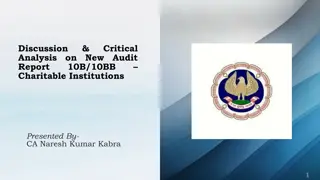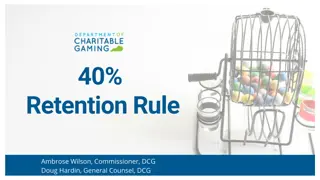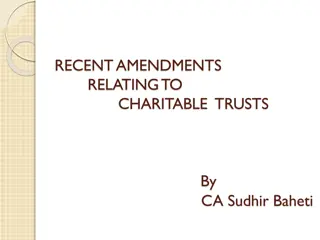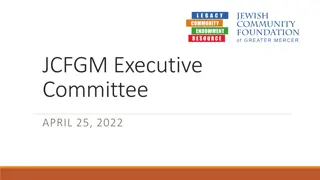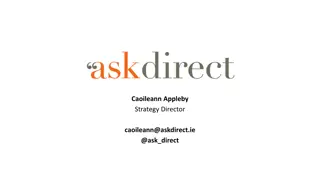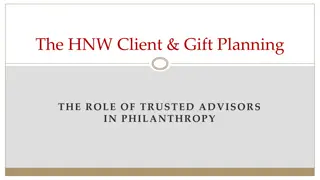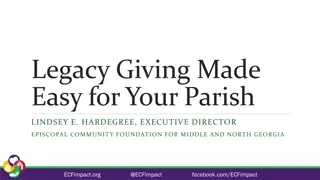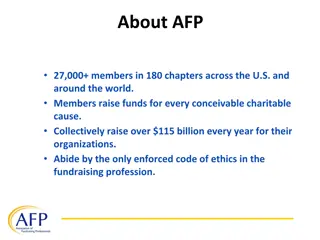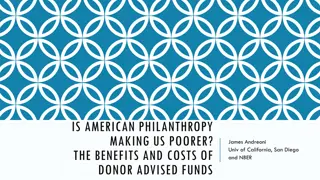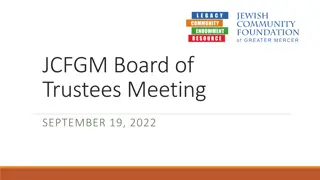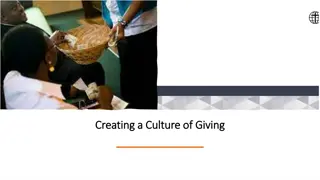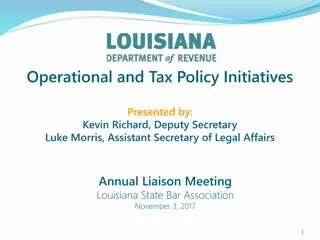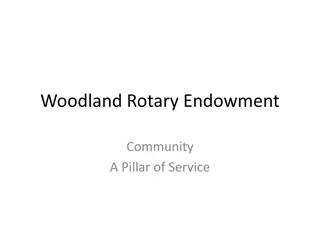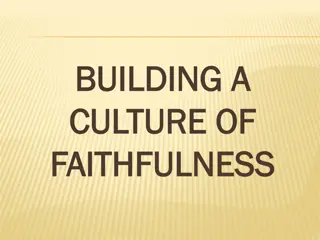Understanding Charitable Giving Trends in the U.S.
Explore the trends and statistics of charitable giving in the U.S., covering topics such as individual giving, foundation contributions, bequest giving, corporate donations, and where the money flows. Delve into historical and current statistics to understand the factors influencing philanthropy in different sectors.
Download Presentation

Please find below an Image/Link to download the presentation.
The content on the website is provided AS IS for your information and personal use only. It may not be sold, licensed, or shared on other websites without obtaining consent from the author. Download presentation by click this link. If you encounter any issues during the download, it is possible that the publisher has removed the file from their server.
E N D
Presentation Transcript
Fairfield Senior Center OCTOBER 13, 2015
Topics Covered During the Next Six Weeks Week 1 (Today) Week 2 Week 3 Week 4 The State of Giving in the U.S. Why People Give Giving in the U.S. versus Philanthropy Overseas Government Spending and Charitable Giving (Crowding Out or Crowding In) Week 5 Corruption in the Nonprofit Sector Nonprofit Malfeasance Week 6 The New Philanthropy and the Principal-Agent Problem
To Get Copy of Slides Go to: www.faculty.fairfield.edu/mleclair Click on link that says Fairfield Senior Center
Week 1 Giving in the U.S. U.S. by far the most generous country in terms of giving per capita Reflection of both higher income and tradition of philanthropy Protestant ethic of taking care of neighbor(s) Giving was up close and personal Also, as will be argued in a later presentation, much of what was once philanthropy is now in the public sector in other developed nations
Current Statistics 2014 Charitable Giving by Source: Individual giving, $258.51 billion, increased 5.7 percent in current dollars over 2013. Foundation giving, $53.97 billion, was 8.2 percent higher than 2013 Bequest giving, $28.13 billion, increased 15.5 percent 2013 Corporate giving, $17.77 billion, increased 13.7 percent over 2013 giving Source: Giving USA
Numbers Reflect a General Trend Foundation and bequest giving is rising at a faster pace than individual giving Represents rapid accumulation of wealth May influence overall patterns of giving in the future For now, individual giving dominates
Where does money go? Religion $114.90 billion, 2014 giving increased 2.5 percent higher Education giving increased to $54.62 billion, 4.9 higher Human Services $42.10 billion total was 3.6 percent higher Health $30.37 billion 2014 estimate was 5.5 percent higher than the prior year Arts/Culture/Humanities $17.23 billion, growth of 9.2
Others Environment/Animals The $10.50 billion estimate for 2014 was up 7.0 percent Public-Society Benefit the $26.29 billion estimate for 2014 increased 5.1 percent International Affairs -- $15.10 billion estimate for 2014 decreased 2.0 percent, in current dollars, from 2013. The drop was 3.6 percent when adjusted for inflation.
What about corporate giving? Why do businesses give? Provides a company with an enlightened image Particularly businesses that may not be viewed favorably by the public Petroleum business, tobacco, etc. Improves work satisfaction among employees Retention may improve Firms may donate to causes that help train needed labor Interest of a top executive might also be a driver
Result-Business Giving Looks Very Different from Personal Giving Largest Participants 1. Novartis Patient Assistance Foundation, Inc. (NJ) $452,981,816 12/31/2013 2. Wells Fargo Foundation (CA) 186,775,875 12/31/2013 3. The Wal-Mart Foundation, Inc. (AR) 182,859,236 01/31/2013 4. The Bank of America Charitable Foundation, Inc. 160,479,886 12/31/2013 5. The JPMorgan Chase Foundation (NY) 115,516,001 12/31/2012 6. GE Foundation (CT) 124,512,065 12/31/2013 7. The Coca-Cola Foundation, Inc. (GA) 98,175,501 12/31/2013 8. Citi Foundation (NY) 78,372,150 12/31/2013
Direction of giving for Corporate Programs Main Destinations were: Education (29%) Health (25%) Community Investment (15%)
Mechanism of Giving Corporate Foundations (34%) Direct Giving (49%) In-Kind (17%) Last category a reflection of drug companies that donate medicines to poorer Americans and to overseas initiatives
Tax Treatment and Total Giving Tax Incentives are a significant driver of giving for those in the upper-income brackets Less, however, than many people assume The standard deduction for a couple filing jointly in now in the range of $12,500. Outside of high-tax, high-property price, Connecticut, you may not reach that by itemizing Tax breaks not a consideration when giving
In much of Europe Tax breaks are available only for specific donations (as in Italy) Another reflection of the subsidiary role played by the charitable sector as opposed to government social spending Discussion is brought up periodically in the U.S. (removal of tax breaks)
Corporate Deduction 5% of Income Provides some incentive to give, but the prime motivator is still need to demonstrate enlightened nature of business This deduction was opposed by many when instituted, given the motives and nature of corporate giving
Uniqueness of U.S. Situation also Reflected in the Mechanisms of Giving Charity Aggregators (United Way) Giving through the workplace (and matching programs) More recent phenomena: Crowdfunding Social Pressure Websites (Hungersite.com) Giving through investing (Impact Investment)
Immigration and Economic Development Political battle in Washington just beginning Support for more open borders coming from strange bedfellows The Democratic Party and the Chamber of Commerce (usually regarded as Republican-leaning) Democrats see a means by which to build up a constituency that is fairly loyal (Hispanics, Asians)
Chamber of Commerce? Conservatives argue that business interests want a growing pool of cheap labor Somewhat confusing argument in an economy that has such a slack labor market Not sure where corporations are having a hard time hiring, except in high-skill occupations
Benefits and Costs of Immigration Skilled immigrant labor highly beneficial to economy Captured endowed human capital in worker Special programs over the years for nurses and workers with other specialized skill sets Unskilled labor more problematic Immigrants perform work that U.S. citizens are unlikely to seek out
Industries with high concentrations of unauthorized workers Most obvious is farming Also see employment in: Construction (roofing!) Packing Painting Landscaping
Benefits Avoid labor shortages common in Europe Labor market more flexible Humanitarian benefits
Costs Evidence of wage suppression @ lower end of market Cost is borne by those at lower end of labor market Social and monetary costs of absorbing millions of individuals No discussion of limits of market to absorb new labor California may have reached that limit already Victor David Hanson s writings
Undermines existing immigration system Difficult to tell people they must go through a multi- year process to achieve legal status when millions are simply entering and staying A well thought-out guest worker program might have been a better way to go Path taken by Germany with Turkish guest workers Although social problems have arisen in Germany also
Week 2 Why People Give Philanthropy is driven by a variety of Motives Some self-interested Reasons for giving partially determines patterns of giving Also provides some insights into how charities should approach donors
Commonly Discussed Motives Altruism/Obligation Warm Glow of Giving (What would Kant Say about this?) Social Stature Self-interest primary motivation for corporate giving
Altruism and Securing Donations Charities use sympathetic message to raise donations May also draw some bad apples into certain segments of charitable sector Charities use key words that elicit a response: Police, fire, veterans, kids, cancer Those that truly give altruistically may get burned if they don t investigate a charity s history
Look More Closely at 2 of The other motives for giving Social Stature Giving is a form of social signaling People who give receive societal respect in return This motive drives people to give to causes that are physically apparent e.g. a hospital wing or a college building May cause a form of competitive giving among elites
Self Interest as a motivator Most obvious example is corporate giving Businesses may give up to 5% of income in any given year and deduct it from earnings Might be driven by philanthropic interests of executives In literature, regarded as a means of advertising the firm as a good citizen to increase sales and profits Donations to the arts, for instance, make a firm appear enlightened
Danger Lurks Nearby Donations to controversial causes may damage business Corporate giving programs gravitate to everyone supports that causes Away from the NRA and Planned Parenthood Research shows that firms that want an enlightened image give to the arts, while manufacturing firms may donate to educational causes that improve the labor force they draw from
Example LeClair, M. and Gordon, K. (2000), Corporate Support for Artistic and Cultural Activities: What Determines the Distribution of Corporate Giving?, Journal of Cultural Economics, 24
More Recent is the Advent of the Ethical Lifestyle Philanthropy (or social action) is part of everyday life Consumption Avoid products from firms that are regarded by some as morally challenged Large problem for Walmart for many years Portrayed in book Nickeled and Dimed by Barbara Ehrenreich
Direct consumption towards firm that are socially responsible Then, seek out consumption products with embedded philanthropic content Fair Trade Products, Products that have a complementary charitable component Girl Scout cookies, Newman s Own products. And buy this product and one dollar goes to breast cancer research promotions
When it Comes to Investing. First, engage in Socially Responsible Investing From the liberal perspective: No oil companies, no firearms manufacturers, no tobacco companies, etc. Could come from a conservative perspective: Avoiding media that conservatives consider biased, for example In general, most SRI arises from the liberal perspective
Examples Socially Responsible Funds
These Funds Necessarily Provide a Lower Long-Term Rate of Return Basic Economic Theory: Constrained Optimization Lower than Unconstrained SRI portfolios do not hold the whole universe of stocks If socially-responsible investing provided a higher rate of return (adjusted for risk), then traditional funds would switch to these stocks
For those that Truly Want to Invest Ethically Impact Investing Funds pursue a social goal as their purpose Sustainable Trade (e.g. Fair Trade) Low-Income Housing (South America) Clean Energy Access (Rural India) Active Programs within U.S. urbans centers
Exaggerated Claims Made About Returns Rates of return are significant for some Impact Funds Risk, however, is very high Unlikely risk-adjusted rate of return is remarkable Continuing argument made above, if Impact Investing created extranormal returns, then conventional funds would rapidly switch investments in this direction
Investors Compensated with Warm-Glow of Engaging in Philanthropy Upper-income individuals may continue to donate, even if returns are lower Raises concern (once again) that Impact Investing (like Fair Trade) is simply an arena for the well-off (a niche) Growth in Impact Investing has been slow, primarily due to inability to explain mechanism to potential investors



